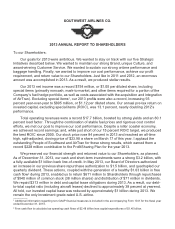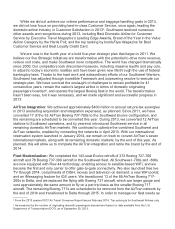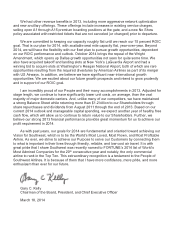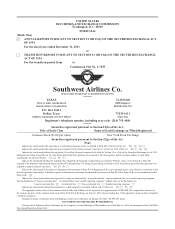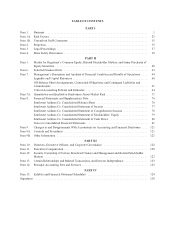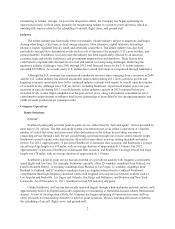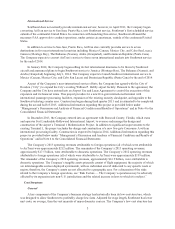Southwest Airlines 2013 Annual Report Download - page 10
Download and view the complete annual report
Please find page 10 of the 2013 Southwest Airlines annual report below. You can navigate through the pages in the report by either clicking on the pages listed below, or by using the keyword search tool below to find specific information within the annual report.terminating in Atlanta, Georgia. As part of its integration efforts, the Company has begun optimizing its
operations in many AirTran cities, primarily by transitioning Atlanta to a point-to-point operation, which is
enabling efficiencies related to the scheduling of aircraft, flight crews, and ground staff.
Industry
The airline industry has historically been an extremely volatile industry subject to numerous challenges.
Among other things, it has been cyclical, energy intensive, labor intensive, capital intensive, technology
intensive, highly regulated, heavily taxed, and extremely competitive. The airline industry has also been
particularly susceptible to detrimental events such as acts of terrorism (for example, 9/11), poor weather, and
natural disasters. In addition, in recent years the industry has been significantly affected by an uncertain
economy, high and volatile fuel prices, and government sequestration and shutdown. These factors have
contributed to unpredictable demand for air travel and related cost and pricing challenges. Reflecting the
numerous industry challenges, from 2001 through 2012 total financial losses for the U.S. airline industry
exceeded $50 billion. As a result, many U.S. airlines have ceased operations or reorganized through bankruptcy.
Although the U.S. economy has experienced a moderate recovery since emerging from a recession in 2009
and the U.S. airline industry has showed measurable improvement during 2013, slow economic growth and
lingering economic uncertainty have led to continued industry restraint with respect to overall capacity (number
of available seats). Although some U.S. air carriers, including Southwest, experienced modest year-over-year
increases in capacity during 2013, overall domestic airline industry capacity in 2013 remained below pre-
recession levels. Leaner flight schedules over the past several years, along with industry consolidation, have
contributed to improvements in industry load factors (percentage of seats filled by fare-paying passengers) and
yields (revenue production per passenger mile).
Company Operations
Route Structure
General
Southwest principally provides point-to-point service, rather than the “hub-and-spoke” service provided by
most major U.S. airlines. The hub-and-spoke system concentrates most of an airline’s operations at a limited
number of central hub cities and serves most other destinations in the system by providing one-stop or
connecting service through a hub. By not concentrating operations through one or more central transfer points,
Southwest’s point-to-point route structure has allowed for more direct non-stop routing than hub-and-spoke
service. For 2013, approximately 72 percent of Southwest’s Customers flew non-stop, and Southwest’s average
aircraft trip stage length was 693 miles, with an average duration of approximately 1.9 hours. For 2012,
approximately 72 percent of Southwest’s Customers flew non-stop, and Southwest’s average aircraft trip stage
length was 678 miles, with an average duration of approximately 1.9 hours.
Southwest’s point-to-point service has also enabled it to provide its markets with frequent, conveniently
timed flights and low fares. For example, Southwest currently offers 25 weekday roundtrips from Dallas Love
Field to Houston Hobby, 11 weekday roundtrips from Phoenix to Las Vegas, 12 weekday roundtrips from
Burbank to Oakland, and 12 weekday roundtrips from Los Angeles International to Oakland. Southwest
complements these high-frequency shorthaul routes with longhaul non-stop service between markets such as
Los Angeles and Nashville, Las Vegas and Orlando, San Diego and Baltimore, and Houston and New York
LaGuardia. As of December 31, 2013, Southwest served 524 non-stop city pairs.
Unlike Southwest, AirTran has historically operated largely through a hub-and-spoke network system, with
approximately half of its flights historically originating or terminating at Hartsfield-Jackson Atlanta International
Airport. As part of its integration efforts, the Company has begun optimizing its operations in many AirTran
cities, primarily by transitioning Atlanta to a point-to-point operation, which is enabling efficiencies related to
the scheduling of aircraft, flight crews, and ground staff.
2

